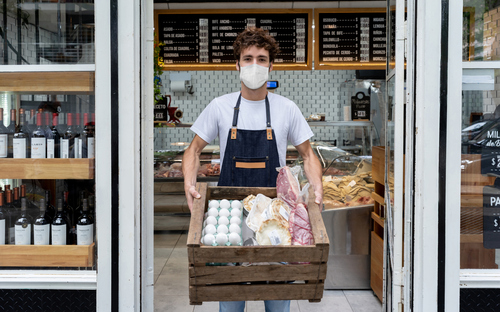Un recul moins important qu’au printemps
Si le secteur de l’hébergement-restauration continue de souffrir du deuxième confinement, l’impact économique a été moindre que celui du printemps pour la majorité des secteurs.
Dans l’industrie et le bâtiment, alors que les entrepreneurs avaient envisagé un recul, l’activité est restée stable au mois de novembre, tout comme dans le secteur de la pharmacie, des autres produits industriels et dans l’agroalimentaire.
À l’occasion de son point mensuel sur la conjoncture économique, la Banque de France a fait part de ses prévisions : le PIB devrait connaître un rebond de 5 % en 2021 et en 2022, et de 2 % en 2023.
« Nous sortons d’une année de brouillard économique. Notre rôle est d’essayer d’y voir clair. La situation est mauvaise, mais il y a quelques raisons d’espérer », a déclaré le gouverneur de la Banque de France, François Villeroy de Galhau, le 14 décembre dans une interview au micro de France Inter.
Au mois de décembre, l’économie française était à -8 % par rapport à l’activité précédant la crise sanitaire, contre -31 % au mois d’avril. Selon François Villeroy de Galhau, « ça veut dire une chose : nous avons appris à travailler en nous protégeant : protocole sanitaire, télétravail, etc. ».
Pas de retour à la normale avant mi-2022
Malgré ces résultats moins inquiétants qu’au printemps, le gouverneur de la Banque de France a souligné qu’avec une activité économique en recul de 9 % en moyenne sur 2020, il s’agissait d’une « récession très sévère, du jamais vu depuis la dernière guerre ».
Selon les dernières estimations, la situation ne devrait pas revenir à la normale avant mi-2022, même si les incertitudes sont nombreuses et que les projections dépendent de l’évolution de l’épidémie. « Nous faisons l’hypothèse que l’épidémie va continuer à exister début 2021, et que le plein effet des vaccins ne sera que fin 2021 », a expliqué François Villeroy de Galhau.
Le niveau d’épargne des ménages fait également partie des incertitudes. « Les Français dépensent moins que d’habitude. Sur l’ensemble de l’année 2021, ils ne toucheront pas à cette part. S’ils décidaient de dépenser plus vite, ça pourrait être un point d’amélioration », a expliqué le gouverneur de la Banque de France, qui estime que l’épargne devrait atteindre les 130 milliards d’euros fin 2020.
Quant au chômage, il devrait frôler les 11 % début 2021, et redescendre à 9 % fin 2022.
